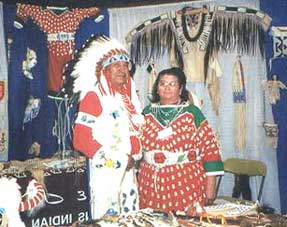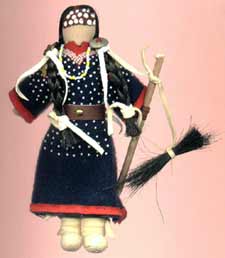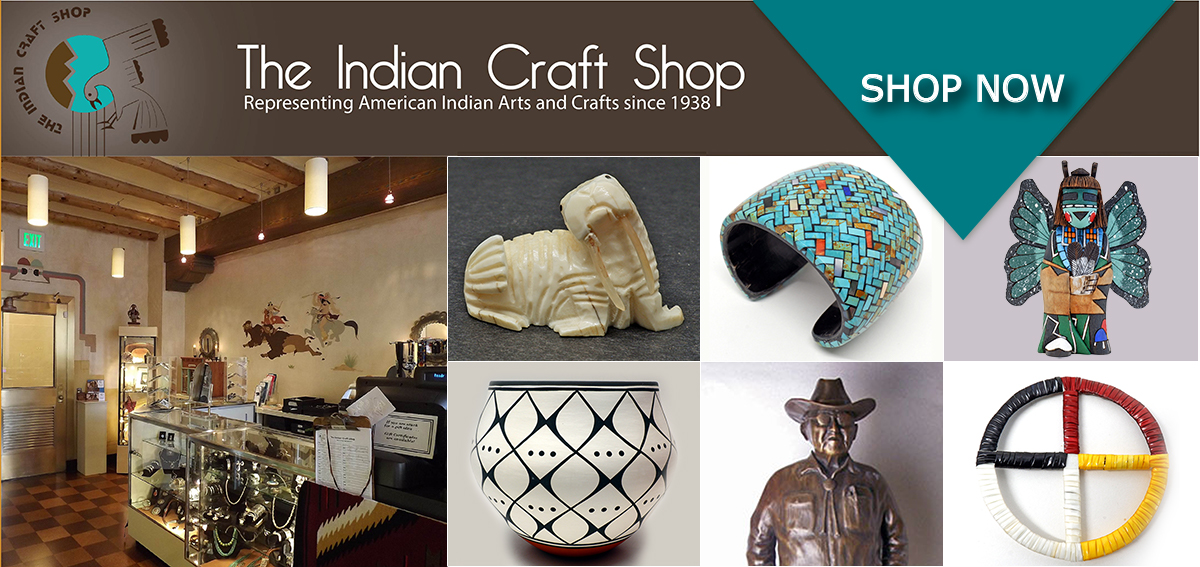Home
About Us
Current News
Event Calendar
Artist Bios
ARCHIVES
Display IDEAS
Collecting Tips
Gen Arts/Crafts Info
Testimonials
Hours/Directions
Online Store
ARCHIVES - Artist / Highlight of the Month
Mary Lou Big Day (Crow) - 2002
The Highlight of the Month program at The Indian Craft Shop focuses on a particular craft area, region or artist family/group. Our aim is to illustrate the diversity of tribal groups and the wide variety of artistic expressions and traditions in the country today.

Mary Lou Big Day was born on the Crow Reservation. Traditional arts have always been an integral part of her life. The oldest of five children, Mary Lou was raised by her grandmother who taught her many things, but it's her mother and father-in-law she credits for teaching her many of the traditional arts of the Crow.
"I was still a girl when I married Heywood at sixteen," says Mary Lou. "That’s 45 years ago. Heywood's father was a Sundance leader, which means that the whole family was needed to help provide support for his work. My mother-in-law was like another mother to me. She taught me beadwork, and how to make moccasins and clothing, as well as how to dry and store meats."

"It was my grandson Heywood III who started me making dolls," says Mary Lou. "He was looking for a way to make some pocket money. So, I worked with my grandson and made a man and woman doll. They sold quickly to a couple from Oregon. My grandson made these dolls from grade school to high school."
When her grandson went to college in Greensboro, he encouraged her to continue making the dolls -- "I'm handing them back to you grandmother," he said.
Mary Lou and her husband Heywood travel across the country selling her dolls and talking about Crow traditions and culture. The dolls were given to young girls to help teach them about their responsibilities as they grew older and to teach them respect for their roles as women -- from giving birth to caring for their children and grandchildren, and later in life, caring for their mothers and grandmothers. Her dolls are also a lesson in history.
Doll dresses trace the changes in Crow women's clothing. Early dresses were made out of buckskin. After contact with Europeans, women began making their dresses out of wool trade cloth. Elk teeth were often used to decorate the tops of the dresses. Influenced by the dress uniforms of the soldiers during the Indian Wars, Crow women began placing a yoke around the neck of the dress. Mary Lou uses elements from each of these styles -- using red, blue, green or yellow wool with yokes in a contrasting color, like the old tradecloth dresses. She adds white beads to simulate the elk teeth.
The bodies are made of leather and the hair is horsehair. The necklaces the dolls wear also have meaning. They represent the ones made by older women who have lost a loved one. These necklaces were worn for protection and passed down through the generations.
Face painting is one of the most important steps in making the dolls. The dolls do not have features, but have traditional face painting designs. Mary Lou mixes the earth paints she uses on each doll. "I pray before painting the faces," says Mary Lou, "because face painting is sacred." The designs used for painting the faces can only be obtained when a family member has had a vision. The design Mary Lou uses is from her family.
Today, Mary Lou's husband Heywood is the Sundance leader. Her support for him takes a lot of her time. However, this mother of four sons, eight grandchildren and one great grandson still finds time to make regalia for her family and dolls for the public. "Through my dolls, I hope to preserve our past heritage for my children, grandchildren and great grandchildren,” says Mary Lou.
©The Indian Craft Shop 2002


